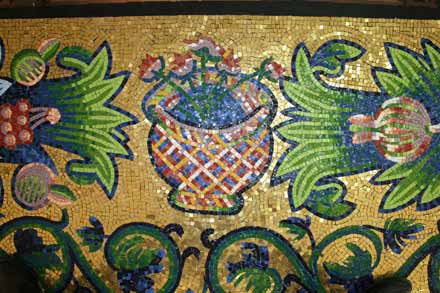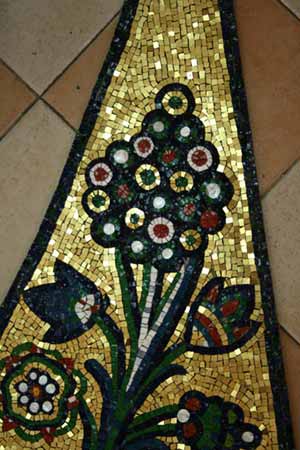
Scroll down the list for other articles.

Dome of the Rock Mosaics TourSource: www.eurojar.org
The exhibition, which was hosted by the Ramallah Cultural Palace from June 24 to July 14, 2009, moved to Bethlehem on August 12 for around two weeks before moving on to Nablus at a later stage. The opportunity
to get acquainted with the Umayyad art Hamdan explains: “The mosaic is located at the very top of the Dome of the Rock, and this makes it difficult for the general public who manage to reach Jerusalem to see it and enjoy its beauty. What we have done through this project is work on bringing some parts of this mosaic closer to the public, along with a detailed description.” He adds: “We have realized 15 square meters of mosaics as an exact copy of the wall of the Dome of the Rock, which was built during the Umayyad era. Since we cannot reproduce the full surface of the 1200 square meter mosaic decorating the Dome’s wall, we selected samples from it and reproduced exact copies while respecting the same colors and size, so that everyone would be able to see and admire this special art.” The EU offered a grant
of 50 thousand Euros to fund this project, which was executed by a team
of 15 specialists from Italy and Palestine who worked on reproducing parts
of the great Dome of the Rock mosaic. In fact, this mosaic is not only
considered to be one of the unique masterpieces in the history of Islamic
art alone, but also in that of human art in general. These reproductions
were made through the use of similar ancient techniques and materials.
This grant is part of the EU’s annual cultural activities program,
which supports and activates the Palestinian cultural heritage Raed Khalil, the Palestinian expert specialized in mosaics, was among the 15 persons who executed the project (with the team including 4 Italian experts). He assured that this “old-new” idea was like a dream for many. He said: “We were extremely happy when the EU agreed to turn dream into reality, especially that the importance of this project lies in the fact that it is a joint Palestinian-Italian cooperation. Moreover, it contributes in spreading awareness among Palestinians on Islamic and historic arts in Jerusalem, which is hard to reach.” Khalil pointed that the team included researchers, engineers, mosaic and printing specialists and everyone was busily working, as “the job took around three months and a half, from February 2009 until the first exhibition in Ramallah was opened in mid-June 2009.” Khalil spoke about the obstacles that faced the team, mainly the inability to reach Jerusalem. Indeed, most of the team members were unable to access the Dome of the Rock, with the exception of those carrying the Jerusalem identity card and foreigners. In addition, the Palestinian territories lack mosaic experts and have no readily available materials for mosaic production. If and when available, these materials are very expensive, and so this is why most of these materials were imported from Italy. Khalil and the team expressed joy at their achievements and hoped that the exhibition in Bethlehem and Nablus would be as successful as it was in Ramallah, and that such exhibitions will be the first step towards other exhibitions in Arab and foreign countries. In this context, he declared: “We have submitted a project for funding the transfer of the exhibition to Arab and foreign states. There are positive signs, but no final agreement for an exhibition abroad has been made yet. We are waiting for funding, and Italy and Greece could be the exhibition’s first hosts.” Raising awareness
of the culture of mosaics Khouloud Deaibes, the Palestinian Minister of Tourism and Antiquities, said that “the exhibition aims at “highlighting the artistic and esthetic value of a first-class religious, architectural, and civilized monument. It is an important work that reflects the depth of the culture inside the sacred city, which we celebrate this year as the capital of Arab culture.” "It is noteworthy that the Rock that was built in Jerusalem in the year 691 is considered one of the most ancient Islamic architectural monuments in the world, with its well-preserved mosaic decorations on a surface of 1200 square meters. The Dome of the Rock’s architecture and decoration reflect its sacred position as well as its rich and deeply-rooted aspects.” Project manager and mosaic expert Carla Benelli said: “The mosaic of the Dome of the Rock is one of the most magnificent mosaics in the world. It is an art that merges Byzantine and Roman technique, Arab Islamic spirit, and Persian craftsmanship. It is thus that we are able through this mosaic to highlight the relation of art with history and the period of prosperity and religious tolerance that prevailed in Jerusalem, especially in the Umayyad era.” Benelli added that she and a number of other Italian experts came to the Palestinian territories and the Middle East upon the initiative of Father Piccirillo, who took it upon himself to preserve some mosaic works in the Palestinian territories, Jordan, and Syria. He restored them and prepared them for the visits of the public and tourists in view of their particular importance among the mosaics that have been discovered in the region and the world. Father Piccirillo worked on securing material and technical support from the Italian government, Italian donors, and the Franciscan monks. According to Benelli, the Palestinians, through the Mosaic Center Jericho and in cooperation with the Italian experts, started since 2000 to give this rare art its due importance through a series of training sessions addressed to Palestinian experts. Moreover, Benelli said that the exhibition “is funded by the EU on the occasion of Jerusalem Capital of Arab Culture 2009. We consider it as an extension of Father Piccirillo’s work and a tribute to his memory following his death in October 2008 and to our role in protecting the mosaic in this danger-ridden region.” In the end, the project coordinator said: “I didn’t expect such amazing results. Perhaps this is due to the fact that the original mosaic of the Dome of the Rock is even more amazing and a rare art masterpiece. We are aware of the complicated situation in Jerusalem on both the political and religious levels, and think that perhaps this exhibition could be a message of tolerance.” She expressed the hope to see the exhibition tour many Arab, European and global capitals.
|
All
content is copyright of © Mosaic Matters and its contributors.
All rights reserved
Mosaic
Matters is:
Editor: Paul Bentley
Web Manager/Designer: Andy Mitchell
 To visit the Dome of the Rock and look at its splendid Islamic mosaic
designs inside and outside the building seems to be hardly possible for
many Palestinians, because of the Israeli military checkpoints and the
racial separation wall, but a tour of “The Dome of the Rock mosaics
come closer” exhibition, which was held upon the initiative of the
Mosaic Center Jericho with a funding by the EU, might be able to compensate
part of this dream and part of the feeling of loss endured by most of
the West Bank residents towards Jerusalem.
To visit the Dome of the Rock and look at its splendid Islamic mosaic
designs inside and outside the building seems to be hardly possible for
many Palestinians, because of the Israeli military checkpoints and the
racial separation wall, but a tour of “The Dome of the Rock mosaics
come closer” exhibition, which was held upon the initiative of the
Mosaic Center Jericho with a funding by the EU, might be able to compensate
part of this dream and part of the feeling of loss endured by most of
the West Bank residents towards Jerusalem.